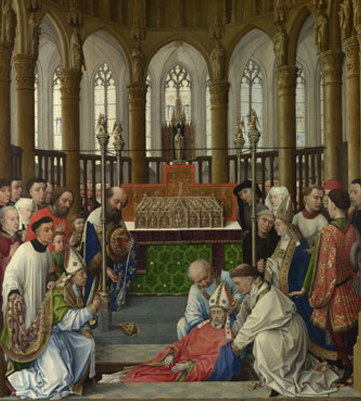They dug Saint Hubert up in the year 743, 16 years after his death, and found his body to have been miraculously preserved from decay. So, at least, it was said. Nearly a hundred years later, Hubert was ex-humed again, this time in the presence of two illustrious witnesses, Louis the Debonair, son of Charlemagne, and Walandus, Bishop of Liege. Same result: the saint stayed a saint.
The Exhumation of Saint Hubert was painted by the workshop of the early Netherlandish artist Rogier van der Weyden in approximately 1437. The painting records exhumation number two, although it contains certain anachronisms. The saint's body is lifted gingerly from a tomb in front of the high altar of an evidently fifteenth-century church, while Walandus and Louis the Debonair, dressed in fifteenth-century clothes, note its intactness. At the back of the scene, the laity crowd round for a view of this momentous event. They gawp and laugh and some of them - particularly the lady in white with the slightly lascivious smile on her face - may even be flirting with one another. The painting divides in two. In the foreground, the miracle; in the background, a glimpse of life in the Low Countries at the time of Rogier van der Weyden and his contemporaries.
This picture was commissioned for the altar of a chapel dedicated to Saint Hubert in the church of Saint Gudule in Brussels. It now hangs in Gallery 56 of the National Gallery's new Sainsbury Wing and seems as miraculously well preserved as Saint Hubert was said to have been after his death. Robert Venturi and De-nise Scott-Brown have clearly looked as carefully at paintings like The Exhumation of Saint Hubert as the elegant, well-lit galleries they have created invite the spectator to do. They have asked themselves some...


